- Books Name
- ACME SMART COACHING Biology Book
- Publication
- ACME SMART PUBLICATION
- Course
- CBSE Class 11
- Subject
- Biology
THE TISSUES
The term tissue was coined by Grew.
A group of similar or dissimilar cells that perform a common function and have a common origin is called tissue.
The tissues are classified into two main groups, namely, meristematic and permanent tissues based on whether the cells being formed are capable of dividing or not.
A. Meristematic Tissues
These tissues consist of cells that retain the power of division.
The protoplasm within the cell is dense, the vacuole is smaller or absent.
These cells are isodiametric, without intercellular spaces.
The nucleus is bigger in size.
These cells have thin cellulosic cell wall.
Metabolically active cells with high surface area per unit volume and nucleo-cytoplasmic ratio.
Ergastic substances are absent.
Colourless proplastids are present in cells.
Concept Builder
Classification of meristems :
(1) On the basis of origin and development
(a) Promeristems (Primordial meristem). A group of cells which represent primary stages of meristematic cells. They are represented by few cells found at the apices of shoots and roots. They give rise to primary meristems.
(b) Primary meristems. They originate from promeristems. They are found below the promeristem at shoot and root apices, at the apex of leaves and in intercalary parts. They give rise to primary permanent tissues after differentiation.
(c) Secondary meristems. They are not present from the beginning of the formation of an organ but develop at a later stage. They give rise to secondary permanent tissues. They develop from primary permanent tissue as a result of dedifferentiation, e.g., interfascicular cambium, cork cambium and cambium in dicot roots.
(2) On the basis of position
(a) Apical meristem. These cells or tissues are found at the apices of stem and root. Due to their continuous division the root and stem increase in length. The apical meristem helps the plants to grow in length.
(b) Intercalary meristem. These tissues are intercalated between permanent tissues. These are actually a part of the apical meristem which gets separated from it during the growth of stem in length. The most characteristic example is the stem of grasses and Equisetum. They are responsible for increase in the length of the stems of grasses especially. They are commonly located at the base of the leaves, above the nodes (e.g. grasses) or below the nodes (e.g. mint).
(c) Lateral meristem.These meristems are present along the lateral side of stem and roots. They divide in tangential plane, giving rise to the secondary permanent tissues to the inside and outside and lead to the increase in thickness or girth of the plant body, e.g., intrafascicular cambium , interfascicular cambium and cork cambium.
(3) On the basis of plane of cell division
(a) Rib or file meristem. The cells divide anticlinally in one plane, so row or column of cells is formed, e.g., formation of lateral roots.
(b) Plate meristem. The cells divide anticlinally in two planes, so plate like area is increased, e.g., formation of epidermis and lamina of leaves.
(c) Mass meristem. The cells divide anticlinally in all planes, so that a mass of cells is formed, e.g., formation of spores, cortex, pith, endosperm.
(4) On the basis of function
(a) Protoderm. These are outermost meristematic cells. They form skin or epidermis of plant and epidermal tissue system.
(b) Procambium. These are innermost meristematic cells. They form primary xylem, primary phloem and cambium.
(c) Ground meristem. They form ground or fundamental tissue such as hypodermis, cortex, pith, pericycle, etc.
Shoot Apex Organisation
Shoot apex is present immediatley above the youngest leaf primordia. It consists of meristematic cells. Lateral branches of stem and leaves are formed by the activity of shoot apex.
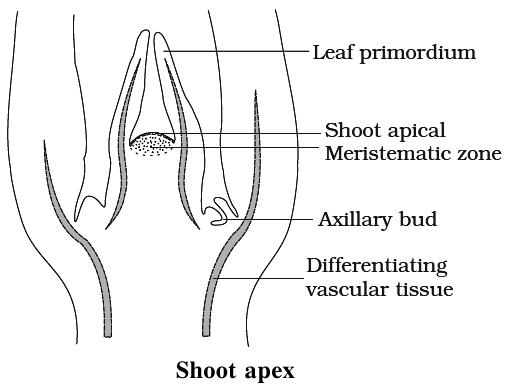
Concept Builder
Many theories have been given to explain shoot apex organisation, such as
(i) Apical cell theory. It was proposed by Hofmeister and Nageli. According to this theory a single apical cell leads to the development of entire plant body. This theory is applicable to algae, as well as to most of the bryophytes and pteridophytes.
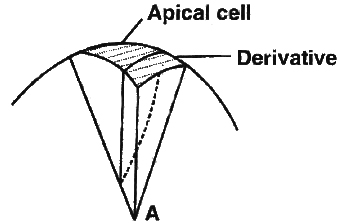
(ii) Histogen theory. It was proposed 'by Hanstein. According to this theory shoot apex consists of following histogens
(a) Dermatogen. Outermost layer. It forms epidermis (skin) and epidermal tissue system.
(b) Periblem. It gives rise to the tissues between epidermis and stele, i.e., cortex and endodermis.
(c) Plerome. Innermost layer. The central mass of cells which gives rise to central stele.
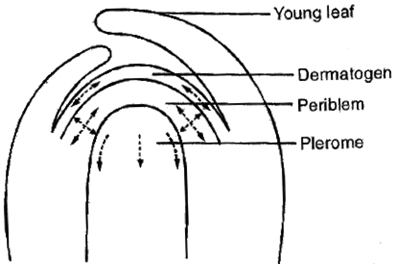
(iii) Tunica-Corpus theory. It was proposed by Schmidt (1924). It is based on plane of division of cells. According to this theory, shoot apex consists of two distinct layers as
(a) Tunica. It is mostly single layered and forms epidermis. The cells of tunica are smaller than corpus and divide by anticlinal divisions mostly.
(b) Corpus. It represents central core with larger cells. The cells divide in all planes (anticlinal and periclinal) .
Sometimes, tunica is multilayered, then only outer layer forms epidermis and the remaining layers with corpus form cortex of shoot.
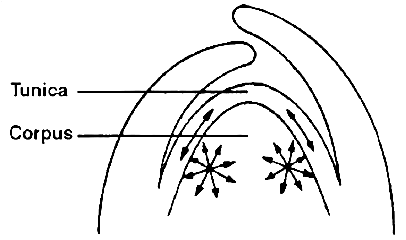
Root Apex Organisation
Root apex consists of mass of meristematic cells.
Root apex is not responsible for the formation of lateral roots.
Root cap is present due to which root meristem becomes subterminal in position.
If root cap is independent in origin, it arises from the calyptrogen.
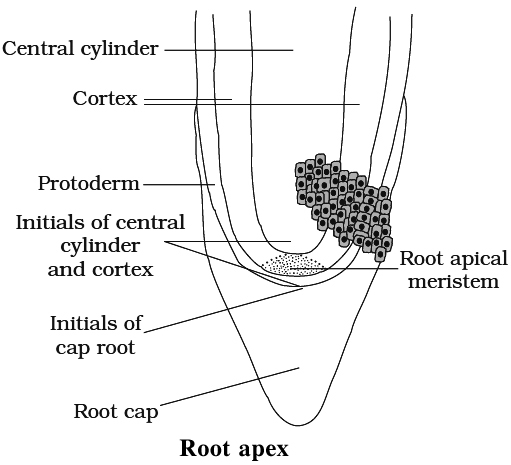
Concept Builder
Regarding the organisation of root apex, following theories have been put forward.
(i) Korper-Kappe theory. It was proposed by Schuepp (1917). This theory is comparable with the tunica and corpus theory of shoot apex because it is also based upon plane of division. Korper means body and Kappe means cap.
(ii) Quiescent centre theory. It was proposed by Clowes (1956-58) in maize. According to this theory, root apex consists of an inverted cup like structure called the quiescent centre. The cells of this region show very low mitotic activity (quiescent) . They have low amount of RNA, DNA and protein. They are surrounded by layer of actively dividing cells which are responsible for formation of different structures of root. These cells divide only when the root apex gets injured.
B. Permanent Tissues
They are composed of living or dead cells which are derived from the meristematic tissue but have lost their ability to divide.
They are primary permanent tissues, if they are derived from apical or intercalary meristem.
They are secondary permanent tissues if they are derived from lateral meristem.
Permanent tissues are mature cells with permanent special structure and function.
These are of three types:
(I) Simple Tissues
(II) Complex Tissues and
(III) Secretory Tissues
(I) Simple tissues
They are made up of one kind of cells performing similar function.
(a) Parenchyma
These cells are found almost in all parts of plants such as roots, stem, leaves, fruits and seeds.
These cells are isodiametric, spherical, oval or polygonal with intercellular spaces.
These cells are living with thin cellulosic cell wall.
Elongated parenchyma with tapering ends is called prosenchyma.
Functions:
(i) The main function is storage of food , e.g., fruits and endosperm.
(ii) Storage of water in fleshy stem and leaves e.g., Opuntia.
(iii) Sometimes, they store secretory substances (ergastic substances) such as tannins, resins and gums and they are called as idioblasts.
(iv) In hydrophytes, they have large intercellular spaces filled with air and are called aerenchyma. They help in circulation of air as well as provide buoyancy to plants.
(v) Sometimes, parenchymatous cells have chloroplast to help in photosynthesis and are called chlorenchyma.

D & E. Aerenchyma
(b) Collenchyma
The term collenchyma was coined by Schleiden.
These cells have thickenings on the cell wall and in corners of intercellular spaces.
It is living mechanical tissue.
They are not found in roots and monocot stems.
These cells form hypodermis in stem and petiol.
The thickening material, in the cell wall contains high amount of pectin and cellulose.
Lignin is absent.
Concept Builder
Collenchyma is of three types :
1. Angular collenchyma - Angular walls thickened e.g., stem of Marigold, Tomato, Datura.
2. Lamellate collenchyma - Tangential walls thickened e.g., stem of Sunflower.
3. Lacunate collenchyma - Lacunate thickening, intercellular spaces are present e.g., stem of Calotropis.
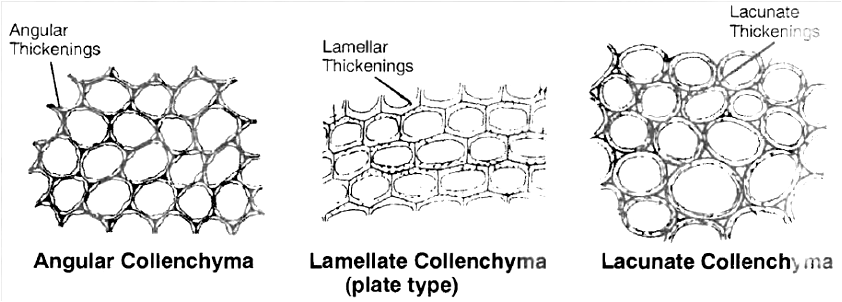
Function :
It provide mechanical support, flexibility and elasticity to the organs and due to peripheral position in stems they resist bending and pulling action of wind . It is especially useful for young plants and herbaceous organs where it is an important supporting tissue.
(c) Sclerenchyma. These cells have thickened secondary walls due to deposition of lignin. On maturity they become dead. These cells have simple pits. They are of two types:
(i) Sclereids
They may be spherical, oval and cylindrical.
They are lignified and extremely thick walled. So the lumen of the cells is almost obliterated.
They are found in hard parts of the plant.
1. Brachysclereids (Stone cells). They are isodiametric and they are found in bark, pith, phloem, cortex, hard endocarp and fleshy portion of some fruits. The grittiness of the fruits like guava and pear is due to these.
2. Macrosclereids (Rod cells). These are elongated, rod like and found in seed coat of leguminous plants.
3. Osteosclereids (Prop cells). These are rod like with dilated ends or barrel shaped e.g., leaves and seed coat of many monocots and seed coat subepidermis in legumes.
4. Asterosclereids (Star cells). These are stellate in form or star shaped. They are common in petiole of floating hydrophytes, like Nymphaea, Lotus and leaves of tea.
5. Trichosclereids (Internal hair). Long, hair like branched sclereids. They are common in hydrophytes and aerial roots of Monstera.
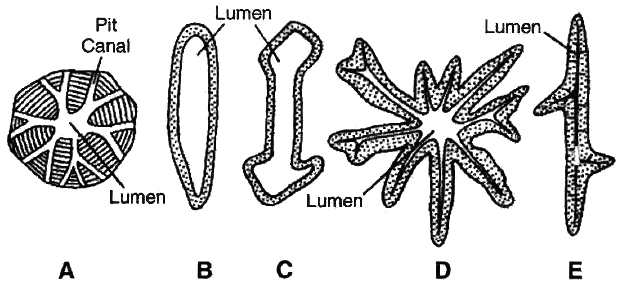
C. Osteosclereid; D. Asterosclereid; E. Trichosclereid
(ii) Sclerenchymatous fibres
They are long with tapering ends.
These are thick-walled cells (lignified).
The fully developed fibre cells are always dead.
The length of fibre varies from 2-550 mm in angiosperms and 1 to 12 mm in gymnosperms.
The fibres are present in hypodermis of monocot stem, in pericycle of many dicots, in secondary wood and in vascular bundle sheath in monocot stems. e.g., Jute, Flax, Hemp etc.
Living fibres are found in Tamarix.
Function: The main function of sclerenchyma is to provide mechanical strength.
(II) Complex tissues
They are made up of different types of cells working as a unit to perform a common function. It includes xylem and phloem.
A. Xylem (by Nageli) or Hadrome (by Haberlandt).
It is chief water conducting element and also provides mechanical strength.
On the basis of origin, xylem is of two types:
(i) Primary xylem
It is derived from procabium during the formation of primary plant body.
It is differentiated into protoxylem (first formed and consists of tracheary elements and xylem parenchyma) and metaxylem (later formed and consists of tracheary elements, xylem parenchyma and fibre).
The cells of metaxylem are bigger in size than protoxylem.
(ii) Secondary xylem.
It is formed from cambium during secondary growth. It is well differentiated into two systems.
(a) Axial or vertical system
1. Tracheary element (Tracheids and Vessels) For conduction of water
2. Xylem or wood fibre For support
3. Xylem parenchyma For storage of food
(b) Ray or horizontal system
Ray parenchyma For storage of food.
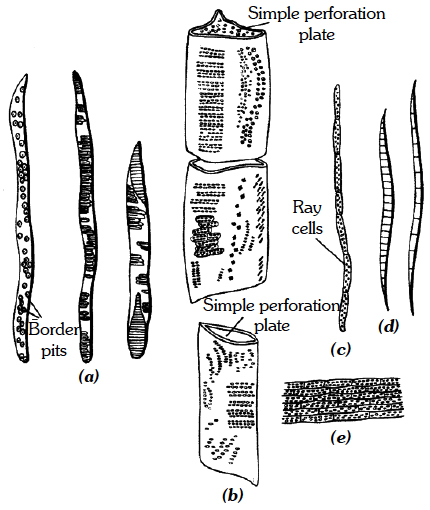
c and e. -Xylem parenchyma, d. Wood fibres wood sclerenchyma)
Xylem consists of following types of cells:
(i) Tracheids.
They are elongated cells with pointed chisel like ends, having no perforations.
Their wall is tough, thickened, lignified and thickening may be annular, spiral, reticulate, scalariform or pitted.
Cells are dead at maturity and have bordered pits.
In pteridophytes and gymnosperms, wood mainly consists of tracheids (no vessels).
In angiosperms, tracheids are associated with vessels.
The main function is conduction of water.
The tracheids are most primitive type of conducting elements in xylem.
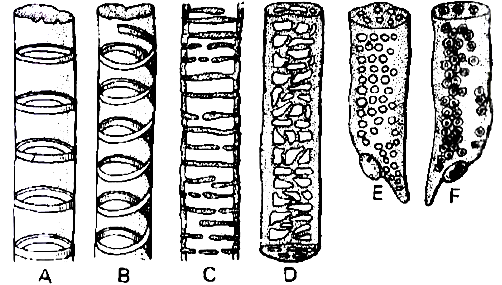
A. Annular B. Spiral C. Scalariform D. Reticulate E. & F. Pitted
(ii) Vessels
They are also elongated and tube like, formed from a row of cells placed end to end.
The partition walls are either perforated or disappear altogether, resulting in an elongated tube.
Walls are thickened and lignified, may have annular, spiral, reticulate or scalariform thickenings.
Vessels are dead at maturity and without nuclei.
The main function is conduction of water.
Vessels are advanced type of conducting elements.
Concept Builder
In pteridophytes and gymnosperms, vessels are absent (non porous wood).
Sometimes, primitive vessels are present in Gnetum and Ephedra (Gnetales).
Vessels are characteristic of angiosperms (porous wood), but they are absent in members of vesselless families like Winteraceae, Trochodendraceae and Tetracentraceae.
(iii) Wood or xylem fibre.
These cells are elongated and pointed at both the ends.
Lumen is completely obliterated.
Cell wall is highly lignified with simple pits.
They are commonly found in secondary xylem.
They may be :
(a) Fibre tracheids. Fibre like tracheids with bordered pits.
(b) Libriform fibre. They have extremely thick walls and simple pits. They provide mechanical support.
(iv) Wood or xylem parenchyma.
They are living parenchymatous cells associated with xylem.
They may occur as axial parenchyma or ray parenchyma.
Concept Builder
When parenchyma is diffused or not associated with vessels, it is called apotracheal parenchyma and when parenchyma surrounds or is associated with vessels, it is called paratracheal parenchyma.
B. Phloem (by Nageli) or Bast or Leptome (by Haberlandt)
It is the main food conducting tissue.
Types of phloem
(a) On the basis of position
(1) External phloem. It is of normal type and is present outside the xylem, e.g., most angiosperms and gymnosperms.
(2) Internal or intraxylary phloem. It originates from procambium and is the primary phloem which occurs on innerside of primary xylem in bicollateral bundles. e.g., Members of Apocyanaceae, Asclepiadaceae, Convolvulaceae, Solanaceae and Cucurbitaceae.
(3) Included or interxylary phloem. It originates from cambium and is secondary phloem which occurs in groups within the secondary xylem, e.g., Leptadaenia, Salvadora, Chenopodium, Boerhaavia, Amaranthus.
(b) On the basis of origin it is of two types:
(1) Primary phloem. It develops from procambium. It does not have radial differentiation or rays are absent. It is differentiated into protophloem (consists of sieve elements and parenchyma) and metaphloem (develops after protophloem and consists of sieve elements, parenchyma and fibre). During the primary growth the protophloem elements are crushed by the surrounding tissues and disappear. This process is known as obliteration.
(2) Secondary phloem. It develops from cambium during secondary growth. It shows radial differentiation. It consists of two distinct systems:
(a) Axial or Vertical system
1. Sieve elements (Sieve tube and companion cells) : For conduction of food
2. Bast fibre : For support
3. Bast Parenchyma: For storage of food
(b) Ray or Horizontal system. Consists of ray parenchyma for storage of food.
Phloem consists of following types of cells
(1) Sieve element.
The sieve elements in angiosperms are sieve tubes which are cylindrical tube like cells with perforated cross walls called sieve plate.
Sieve tubes are associated with companion cells and they are without nuclei.
In pteridophytes and gymnosperms the sieve elements have sieve plates on their lateral walls and are called sieve cells and companion cells are absent.
The walls of sieve tube elements are made up of cellulose and pectic substances.
The cytoplasm is confined to a thin peripheral layer.
P-proteins (Phloem protein) are proteinaceous structures present in sieve tubes and are believed to be responsible for (i) movement of materials and (ii) sealing of pores after wounding.
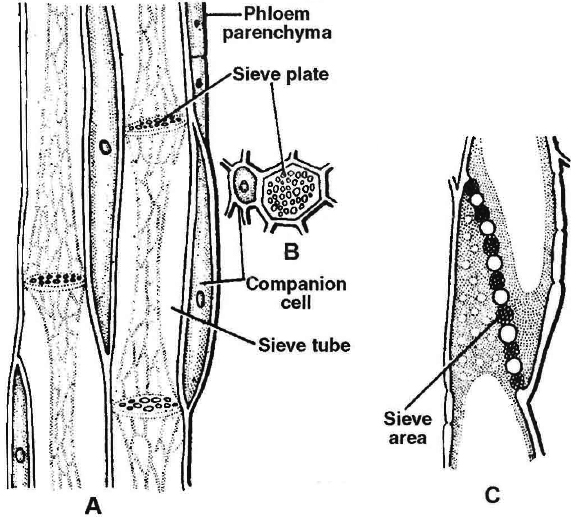
C. L.S. of sieve plate
At the end of growing season a callose plug (made of callose carbohydrate) is deposited on sieve plate in old sieve tubes which inhibits the activity of sieve tubes.
In spring season the callose plug gets dissolved.
(2) Companion cells.
They are elongated, living, parenchymatous, thin walled cells.
They are associated laterally to sieve tubes and have dense cytoplasm and nuclei.
Companion cells are absent in pteridophytes and gymnosperms.
Both sieve tubes and companion cells are related ontogenetically because both develop from the same mother cell.
So, these are called sister cells.
(3) Phloem or bast fibre.
They are absent or fewer in primary phloem and abundantly found in secondary phloem.
They are sclerenchymatous and unbranched fibres associated with phloem.
Phloem fibres of plants like jute, flax and hemp are retted in water and extracted for making ropes and coarse textiles.
(4) Phloem parenchyma.
They are parenchymatous living cells with cellulosic cell wall and nucleus.
The main function is storage of food.
They are not found in monocotyledonous plants.
(III) Secretory Tissues ¬
These tissues perform special function in the plants e.g., secretion of resin, gum, oil and latex.
Concept Builder
These tissues are of two types :
(1) Laticiferous tissues.
They are made up of thin walled, elongated, branched and multinucleate (coenocytic) structures that contain colourless, milky or yellow coloured heterogenous substance called latex.
These are irregularly distributed in the mass of parenchymatous cells.
These tissues are of two types¬ –
(a) Latex cells. They do not fuse and do not form network. Such tissues are called simple or non-articulated laticifers e.g., Calotropis (Asclepiadaceae), Nerium, Vinca (Apocyanaceae), Euphorbia (Euphorbiaceae), Ficus (Moraceae).
(b) Latex vessels. They are formed due to fusion of cells and form network like structure. Such tissues are called compound or articulated laticifers, e.g., Argemone Papaver (Papaveraceae), Sonchus (Compositae), Hevea (rubber plant), Manihot (Euphorbiaceae).
The latex of some plants is of great commercial importance such as¬
(i) Source of commercial rubber is latex of Hevea brasiliensis, Ficus elastica, Cryptostegia, Manihot glaziovii.
(ii) Source of chewing or chickle gum is latex of Achras sapota.
(iii) Source of enzyme papain is latex of Carica papaya. .
(iv) Source of alkaloid opium is latex from immature capsules of Papaver somniferum (Poppy)
(2) Glandular tissues.
They include different types of glands which secrete oils, gums, mucilage, tannins and resins.
They may be :
(a) External glands. They generally occur on the epidermis of stem and leaves e.g., glandular hair in Utricularia, nectar secreting glands in flowers, digestive enzyme secreting glands) in Drosera, Nepenthes (insectivorous plants).
(b) Internal glands. These are present internally, e.g., oil glands in Citrus and Eucalyptus, resinous ducts in Pinus (schizogenous origin) and mucilage secreting glands in leaves, of Piper betel. The glands which secrete essential oils are called osmophores.
Chapter 6
Anatomy of flowering plants
Both plants and animals have structural similarities and differences in their outward appearance that can be easily viewed. Furthermore, the interior structure of living creatures shares certain characteristics. The internal structure and organization of higher plants are discussed in this chapter. Anatomy is the study of a plant's interior structure. Cells are the basic unit of plants, and cells are organized into tissues, which are then organized into organs. Different organs of a plant have different internal structures. Monocots and dicots are considered to be physically distinct within angiosperms. Internal structures also exhibit environmental adaptations.
Tissues
A tissue is a collection of cells that share the same origin and typically execute the same function. Different types of tissues make up a plant. Tissues are divided into two categories: meristematic and permanent tissues, depending on whether or not the cells forming them are capable of dividing.
A. Meristematic Tissues
Meristematic tissue is a type of plant tissue that can divide continuously throughout its existence. Plant growth is generally restricted to meristems, which are specialized regions of active cell division. Meristems come in several forms in plants. Primary meristems include apical and intercalary meristems, which arise early in a plant's life and contribute to the production of the primary plant body.
Apical meristems are meristems that form at the terminals of roots and shoots and create primary tissues. The root apical meristem is found at the root's tip, while the shoot apical meristem is found at the far end of the stem axis. The axillary bud is formed by cells left over from the shoot apical meristem after the production of leaves and stem elongation. These buds can develop a branch or a flower and can be found in the axils of leaves.
Intercalary meristem is a type of meristem that arises between mature tissues. They are present in grasses and restore sections of the plant that have been eaten by grazing herbivores. They are found in the leaves and internodes. These contribute to the internode's lengthening. It is also present in monocots, and pine trees. It contributes to the plant's height.
The secondary or lateral meristem is found in the mature portions of roots and shoots of many plants, especially those that generate woody axes and develop later than the primary meristem. They are meristems that are cylindrical. Lateral meristems include the fascicular vascular cambium, interfascicular cambium, and cork-cambium. The secondary tissues are produced by these cells. Following cell division in both primary and secondary meristems, newly produced cells become architecturally and functionally specialized, and their ability to divide is lost. Permanent or mature cells are the cells that make up the permanent tissues. Specific parts of the apical meristem produce dermal tissues, ground tissues, and vascular tissues during the creation of the main plant body.

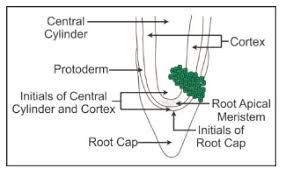
B. Permanent Tissues:
Permanent tissues are made up of mature cells that have lost their ability to divide and have taken on a permanent shape, size, and function as a result of meristematic tissue development and differentiation. These tissues' cells can be alive or dead, thin-walled or thick-walled. Permanent tissue cells do not usually divide any further. They are divided into simple tissues and complex tissues.
Simple tissues
are permanent tissues with all cells having the same structure and function.Only one sort of cell makes up a basic tissue. Plants have parenchyma, collenchyma, and sclerenchyma as simple tissues. The parenchyma cells form a majority of the living cells in the plant. The parenchyma's cells are usually isodiametric. They come in a variety of shapes, including spherical, oval, round, polygonal, and elongated. Their cellulose-based walls are quite thin. They might be tightly packed or with minor intercellular gaps. Photosynthesis, storage, and secretion are all processes performed by the parenchyma. In most dicotyledonous plants, the collenchyma is found in layers beneath the epidermis. It can be found as a single layer or in patches. It is made up of cells that have thickened at the corners due to cellulose, hemicellulose, and pectin deposition.Collenchymatous cells can be oval, round, or polygonal, and chloroplasts are common. When chloroplasts are present, these cells digest food. There are no intercellular spaces. They offer mechanical support to the plant's growth portions, such as the young stem and leaf petiole. Long, narrow cells with thick, lignified cell walls and a few or many pits make up sclerenchyma. They are frequently devoid of protoplasts and lifeless. Sclerenchyma can be classified as fibers or sclereids based on differentforms, structures, origins, and development. Fibers are thick-walled, elongated, cells that can be found in groups throughout the plant. Sclereids are dead cells that are spherical, oval, or cylindrical in shape and have very thin cavities (lumen).These are often found in nut fruit walls, fruit pulp such as guava, pear, and sapota, legume seed coats, and tea leaves. Organs are supported mechanically by sclerenchyma.
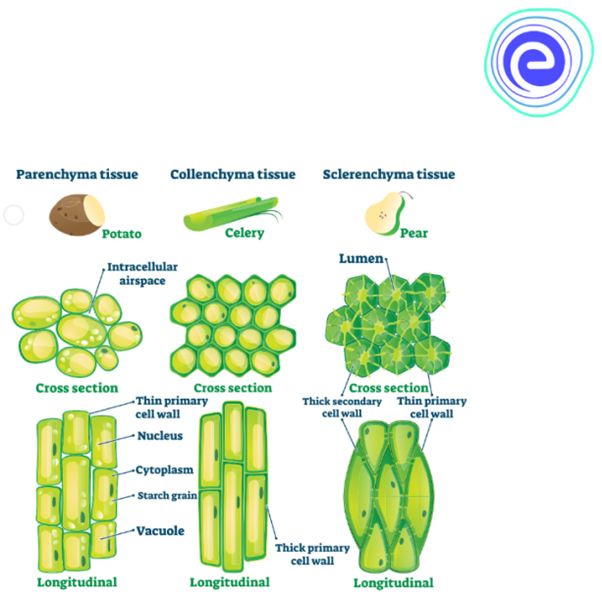
Complex tissues
are permanent tissues that contain a variety of cell types.They are made up of multiple cell types that work together as a unit. Plants have complex tissues called xylem and phloem. From the roots to the stem and leaves, the xylem serves as a conduit for water and minerals. It also gives the plant parts mechanical strength. Tracheids, vessels, xylem fibres, and xylem parenchyma are the four types of elements that make up the xylem. The xylem of gymnosperms is devoid of vessels. Tracheids are long, tube-like cells with lignified walls and tapering ends. These have no protoplasm and are dead. The inner layers of the cell walls feature different types of thickenings. Tracheids and vessels are the principal water transportation elements in blooming plants.A vessel is a long cylindrical tube-like structure composed of multiple vessel parts, each with lignified walls and a big central chamber. The vascular cells are also protoplasm-free. Members of the vessel are linked through perforations in their common walls. Angiosperms are characterized by the presence of vessels. The walls of xylem fibers are thicker and the central lumens are destroyed. These can be septate or aseptate in nature. Xylem parenchyma cells are live, thin-walled cells with cellulose-based cell walls. They store food items such as starch or fat, as well as other compounds such as tannins. The ray parenchymatous cells are responsible for water radial conduction.
Protoxylem and metaxylem are the two forms of primary xylem. Protoxylem refers to the first created primary xylem elements, while metaxylem refers to the later formed primary xylem components. The protoxylem is located at the organ's center (pith), while the metaxylem is located near the organ's perimeter. Endarch is the name for this sort of primary xylem. Protoxylem is found on the periphery of roots, while metaxylem is found in the centre. Exarch is the name for this type of primary xylem configuration. Food supplies are transported via phloem from leaves to other sections of the plant. Sieve tube elements, companion cells, phloem parenchyma, and phloem fibres make up phloem in angiosperms. Albuminous cells and sieve cells are found in Gymnosperms. Sieve tubes and companion cells aren't present.
Sieve tube elements are similar to companion cells in that they are long, tube-like structures that are aligned longitudinally. The sieve plates are formed by perforating their end walls in a sieve-like pattern. A developed sieve element has a big vacuole and peripheral cytoplasm but no nucleus. The nucleus of companion cells controls the actions of sieve tubes. Companion cells are specialized parenchymatous cells that are intimately linked to sieve tube elements. Between their common longitudinal walls, pit fields connect the sieve tube elements and companion cells. The partner cells aid in maintaining the sieve tubes' pressure gradient. Elongated, tapered cylindrical cells with rich cytoplasm and nucleus make up phloem parenchyma.The cellulose cell wall has pores through which plasmodesmata connections between cells can be made. Food and other compounds like as resins, latex, and mucilage are stored in the phloem parenchyma. The majority of monocotyledons lack phloem parenchyma. Sclerenchymatous cells make up phloem fibers. The primary phloem is devoid of them, whereas the secondary phloem has them. These are long and unbranched, with sharp, needle-like apices. Phloem fibers have a very thick cell wall. These fibers lose their protoplasm and die as they mature. Protophloem is the first created primary phloem, which has tiny sieve tubes, and metaphloem is the second formed primary phloem, which has larger sieve tubes.
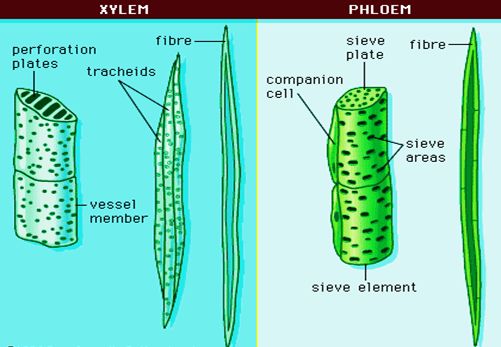
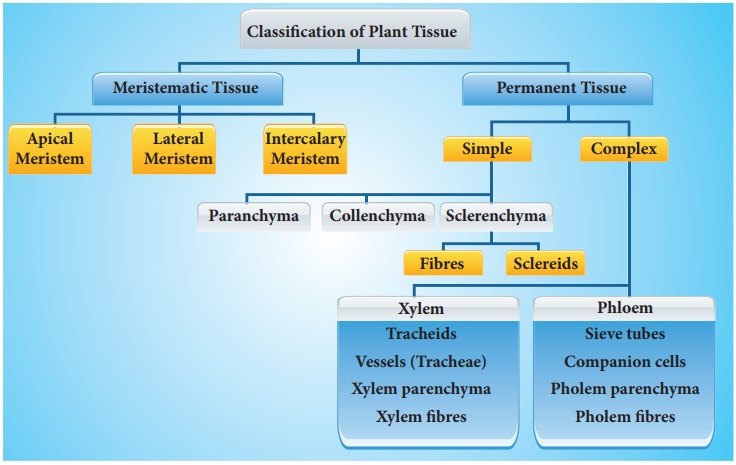

 ACME SMART PUBLICATION
ACME SMART PUBLICATION
